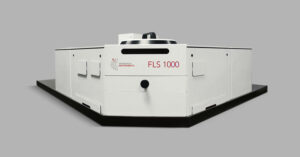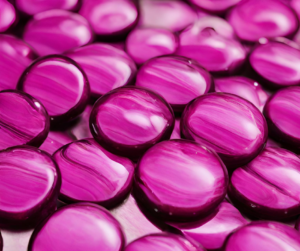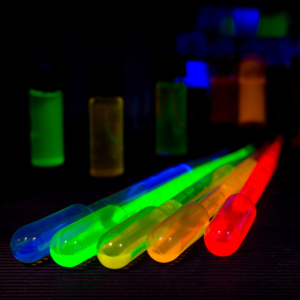Mid-infrared (MIR) lasers appeal to research and industry due to their versatile applications. They are critical for molecular spectroscopy, defence, medical diagnostics, and optical communications systems due to strong atmospheric transmission in specific spectral windows. In addition, thanks to their compact size, MIR lasers can be integrated into portable analytical instruments and field-deployable sensors.
To achieve efficient emission, MIR laser gain media can be doped with rare-earth ions, such as holmium (Ho3+), erbium (Er3+), thulium (Tm3+), and dysprosium (Dy3+). Dy3+ has been recognised as an active ion with high potential in MIR lasers. With a suitable host material, Dy3+ enables efficient lasing from 2.4 μm to 6.2 μm. A recent study conducted by multiple research groups in China investigated the optical properties of calcium fluoride-strontium fluoride (CaF2-SrF2) doped with various Dy3+ concentrations using an Edinburgh Instruments FLS1000 Photoluminescence Spectrometer. Their findings were published in Crystals.
The optical characterisation of the Dy:CaF2-SrF2 crystal was performed using an FLS1000 spectrometer (Figure 1) with a double excitation monochromator.
Figure 1. Edinburgh Instruments FLS1000 Photoluminescence Spectrometer.
An FLS1000 configuration with two emission monochromators allowed for the accommodation of a visible PMT-900 detector, a liquid nitrogen NIR PMT-1700, and a dual-mode MIR InSb-5.5 μm detector with cutoffs at 900 nm, 1.7 μm, and 5.5 μm, respectively. The dual mode of the InSb enabled steady-state and lifetime measurements to be carried out within the detector’s range (1.5-5.5 μm). In terms of light sources, the spectrometer was equipped with a 450 W Xe lamp, a 60 W Xe μs flash lamp, a 2 W 808 nm laser diode operating in both CW and pulsed modes, and picosecond pulsed diodes from the Edinburgh Instruments EPL and EPLED series. The samples were held using the FLS1000’s front-face sample holder.
Emission spectra and photoluminescence (PL) lifetimes of the Dy:CaF2-SrF2 crystal using the dual-mode MIR InSb detector were acquired at different doping concentrations of Dy3+, which were 5 atomic percent (5 at.%), 10 at.%, and 15 at.% (Figure 2).
Figure 2. Dy:CaF2-SrF2 crystals of a) 5 at.%, b) 10 at.%, and c) 15 at.%. The image is reprinted from L. Zheng et al., Copyright (2021), with permission from MDPI through an Open Access License.
The host crystal, CaF2-SrF2, was chosen because it exhibits a low phonon energy, which prevents electrons from being promoted to intermediate energy levels. Therefore, non-radiative decays are less likely to occur, thereby enhancing the crystal’s efficiency.
Two excitation wavelengths were used for the steady-state measurements: 1320 nm and 808 nm. In the 1320 nm case (Figure 3a), the variation in PL intensity around 1970 nm is evident as the Dy3+ doping concentration changes. The emission peak at 1970 nm corresponds to the energy level transition from 6H9/2 + 6F11/2 to 6H15/2, and the maximum PL intensity is observed for the minimum Dy3+ doping concentration (5 at.%). A potential explanation for this is that at 5 at.% doping, the Dy3+ ions are relatively isolated, minimising quenching effects, such as energy transfer between ions, and thus, maximising the PL intensity. It was also noted that the emission band at 2900 nm remained unaffected by changes in the doping concentration.
Figure 3. Emission spectra of the Dy:CaF2-SrF2 crystal under different excitation wavelengths: a) 1320 nm and b) 808 nm. The image is reprinted from L. Zheng et al., Copyright (2021), with permission from MDPI through an Open Access License.
Pumping the crystal with a different excitation wavelength (808 nm) reveals a variation in the PL intensity around 2900 nm, which is now dependent on the Dy3+ doping concentration (Figure 3b). The highest PL intensity is observed at 15 at.%, indicating different quenching efficiencies for interstitial fluoride ions when pumped by 808 nm excitation.
The PL lifetime decays at 2900 nm were acquired using the MIR InSb detector and a 2 W laser diode operating at 808 nm in pulsed mode. The results showed that the longer lifetime was for the 5 at.% Dy+3 (743.6 μs, Figure 3a), indicating minimum energy transfer between ions, thus strengthening the crystal’s radiative transitions. On the other hand, the shortest lifetime was observed for the 15 at.% Dy+3 (194.7 μs, Figure 3c), suggesting a potential dominance of quenching mechanisms and resulting in shorter lifetime components.
Figure 4. PL lifetime decays of the Dy:CaF2-SrF2 crystal at different Dy+3 doping levels: a) 5 at.%, 743.6 μs, b) 10 at.%, 339.2 μs, and c) 15 at.%, 194.7 μs. The image is reprinted from L. Zheng et al., Copyright (2021), with permission from MDPI through an Open Access License.
An Edinburgh Instruments FLS1000, equipped with a dual-mode MIR InSb detector, was used to study the optical properties of a Dy:CaF2-SrF2 crystal at varying Dy+3 doping concentrations. The steady-state and time-resolved results showed promising potential in developing MIR lasers.
The results presented in this research highlight were published in Crystals, and more details are available at https://www.mdpi.com/2073-4352/11/8/907.



